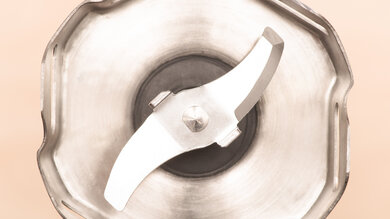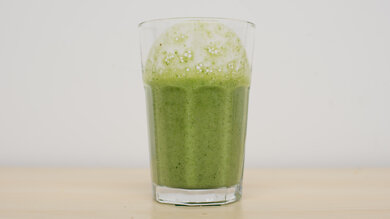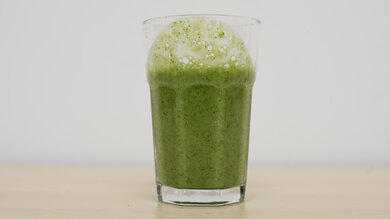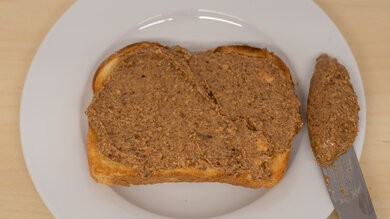The KitchenAid KHBBV53 is an immersion blender that can hot blend ingredients to make soups, sauces, and other foods. It's cordless, so you'll need to charge it up before you use it, and the manufacturer says it can blend about 25 bowls of soup (12 ounces each) on a full charge. There's a beaker included that you can use for blending small batches of sauce or something like a smoothie, and the blending arm is detachable and dishwasher-safe. Unfortunately, it doesn't have a very premium look or feel.
Our Verdict
The KitchenAid KHBBV53 is alright for multi-purpose use. Like most immersion blenders, it's mostly meant for hot blending directly in a pot or pan. It makes a decently smooth blend with fibrous ingredients, so it's alright for recipes like kale smoothies as well as pureed soups and sauces. It's not easy to use for thicker recipes but can make reasonably smooth nut butter or hummus in a pinch. It doesn't come with any extra accessories like a whisk or beaters, though, and it's not very well-built.
-
Can hot blend.
-
Quiet when it's running.
-
Not suitable for ice crushing.
-
Sub-par build quality.
The KitchenAid KHBBV53 is okay for single-serve smoothies. It struggles to crush ice, and if your smoothie contains fibrous elements like leafy greens or fruit skin, it will have a somewhat grainy texture. Still, it does a decent job blending fibrous fruits and vegetables, especially compared to other battery-powered personal blenders. It's easy to clean by hand, and the blending arm is dishwasher-safe. There's also a beaker included that's a good size for something like a single-serve smoothie.
-
Adequate for blending fibrous ingredients.
-
Quiet when it's running.
-
Not suitable for ice crushing.
-
Sub-par build quality.
The KitchenAid KHBBV53 is decent for multiple servings of smoothies. Since it's an immersion blender, you can blend in your own pitcher and aren't limited by the beaker's 20oz capacity. It makes a fairly smooth blend with fibrous ingredients, and while it doesn't completely liquify kale or blueberries like the best smoothie blenders can, it does a good job for an immersion blender. It's also easy to clean by hand and quiet while it's running. That said, immersion blenders can be tiring to use for big batches because you need to hold the blender the entire time.
-
Adequate for blending fibrous ingredients.
-
Quiet when it's running.
-
Not suitable for ice crushing.
-
Sub-par build quality.
The KitchenAid KHBBV53 isn't good for crushing ice. The blades can reach ice cubes and crush them one at a time, but it's a slow and tedious process. It's also not very well-built.
-
Quiet when it's running.
-
Not suitable for ice crushing.
-
Sub-par build quality.
The KitchenAid KHBBV53 is fantastic for soups. It's meant for blending hot ingredients for recipes like soups and sauces directly in a pot or pan. There's a pan guard included to help protect non-stock cookware. Its cordless design gives you more freedom to move around the kitchen too. Compared to other battery-powered models like the Cuisinart EvolutionX, it makes a smoother blend with fibrous ingredients. Recipes with tough ingredients like kale and broccoli can still have a somewhat grainy texture.
-
Can hot blend.
-
Adequate for blending fibrous ingredients.
-
Quiet when it's running.
-
Sub-par build quality.
The KitchenAid KHBBV53 is decent for professional use. It's not well-built, which is a downside if you use your blender every day, but its cordless design makes it easier to move around the kitchen. It makes a fairly smooth blend with fibrous ingredients like broccoli and does even better with smaller batches. It's also easy to clean by hand, and the detachable blending arm is dishwasher-safe.
-
Can hot blend.
-
Adequate for blending fibrous ingredients.
-
Quiet when it's running.
-
Sub-par build quality.
- 6.6 Multi-Purpose
- 6.7 Smoothies (Single Serving)
- 7.0 Smoothies (Multiple Servings)
- 4.8 Ice Crushing
- 9.0 Soups
- 7.1 Professional Use
- Updated Apr 22, 2024: Compared its build quality to the newly-reviewed KitchenAid Go Cordless Hand Blender's.
- Updated Mar 10, 2023: Updated text to match Test Bench 1.0.
- Updated Feb 27, 2023: Updated the result for jar capacity to N/A, because immersion blenders are meant for blending in your own container like a pot or pan.
- Updated Feb 23, 2023: Added a comparison with the Crux Artisan Series Cordless Immersion Blender's control scheme.
- Updated Sep 09, 2022: Converted to Test Bench 1.0.
- Updated Oct 28, 2020: Review published.
- Updated Oct 23, 2020: Early access published.
- Updated Oct 13, 2020: Our testers have started testing this product.
- Updated Oct 08, 2020: The product has arrived in our lab, and our testers will start evaluating it soon.
- Updated Oct 01, 2020: We've purchased the product and are waiting for it to arrive in our lab.
Differences Between Sizes And Variants
The KitchenAid KHBBV53 or KitchenAid Cordless Variable Speed Hand Blender comes in seven different colors: 'Black Matte', 'Matte Charcoal Grey', 'Empire Red', 'Onyx Black', 'Passion Red', 'Blue Velvet', and 'White'. Aside from the motor body, it includes a beaker, lid, blending arm, charger, and pan guard, and isn't available with any other set of accessories.
We tested it in 'Empire Red', and you can see the label for the model we tested here. We expect the other color variants to perform similarly.
If you come across another version of this blender, let us know in the discussions, and we'll update our review.
Compared To Other Blenders
The KitchenAid KHBBV53 is a hand blender with a beaker and a plastic guard to help protect non-stick pans when you're blending. It's battery-operated and makes a smoother blend with fibrous fruits and vegetables than other cordless models we've tested, including the Crux Artisan Series Cordless Immersion Blender and the Cuisinart EvolutionX RHB-100. Its plasticky build quality is a downside, though.
For more options, see our recommendations for the best blenders, the best immersion blenders, and the best blenders under $100.
The Cuisinart Smart Stick Two-Speed Hand Blender and the KitchenAid KHBBV53 have different strengths. The KitchenAid is a battery-powered blender that makes a smoother blend with big batches of fibrous ingredients. It has a longer arm that makes it better for blending in deep pots, and it's much quieter when it's running. On the other hand, the Cuisinart is a plug-in blender, so you're not limited by battery life. It's lighter and makes a smoother blend with small batches of ingredients like kale, so you might prefer it for recipes like single-serve smoothies.
The Breville Control Grip is a better immersion blender than the KitchenAid KHBBV53. The Breville is better built and comes with a variety of accessories, including a food processing bowl with its own blade assembly for chopping. It makes smoother, more spreadable nut butter. However, you might prefer the KitchenAid's cordless design. It's much quieter when it's running. It also makes a smoother blend with larger amounts of fibrous ingredients, which is nice if you need to blend big batches of soup in a deep pot.
The KitchenAid KHBBV53 and the Braun MultiQuick 7 have different strengths. The Braun is much sturdier and comes with a variety of accessories, like a food processing bowl with its own blade assembly and a whisk. On the other hand, the KitchenAid is cordless. It's also better at blending fibrous ingredients, so it can make smoother soups and smoothies with ingredients like kale and broccoli.
The Braun MultiQuick 5 and the KitchenAid KHBBV53 have different strengths. The Braun is much sturdier. It comes with a whisk and produces better results when it comes to making thick mixtures like nut butter or hummus. However, the KitchenAid has a cordless design, which you might like if your kitchen is short on plugs near the stove. It makes a smoother blend with fibrous ingredients, which is important for recipes like pureed soups and smoothies.
The KitchenAid KHBBV53 and the KitchenAid 5-Speed Hand Blender have different strengths. The KHBBV53 is cordless, which you might prefer, and it can produce a smoother blend with fibrous ingredients, so it makes better-blended soups and smoothies. However, the 5-Speed comes with a lot of accessories and attachments, including a food processing bowl and an 'S-blade' assembly that helps it do a better job of crushing ice than most immersion blenders.
The KitchenAid KHBBV53 and the Bamix Mono M133 have different strengths. The KitchenAid is battery-powered, so you can easily move around your kitchen with it. It's also better at processing fibrous ingredients, so it can make smoother soups with kale or broccoli. It's also quieter, but you need to keep it charged up, and you're limited by the battery life. The Bamix is a plug-in blender with a much better build quality. It also comes with whisk and beater attachments for making things like salad dressing or cake batter.
The KitchenAid KHBBV53 is better than the Cuisinart EvolutionX RHB-100. They're both cordless, but the KitchenAid can make a much smoother blend with fibrous fruits and vegetables, resulting in better-blended broccoli soups and blueberry smoothies. It's also significantly quieter when it's running. On the other hand, the Cuisinart is lighter, so you might find it less tiring to use. It also comes with a whisk attachment that can help with making whipped cream or hollandaise sauce.
The KitchenAid Variable Speed Corded Hand Blender and the KitchenAid KHBBV53 have a similar design, but the KHBBV53 is cordless. The KHBBV53 also offers a better blending performance since it makes a smoother blend with big batches of fibrous ingredients. It's quieter when it's running. However, you're limited by the battery life, and the corded model has a sturdier build quality.
The KitchenAid KHBBV53 is a slightly better battery-powered blender than the Cuisinart Smart Stick Cordless Hand Blender. The KitchenAid can make a smoother puree with fibrous ingredients like kale and is also quieter and easier to clean by hand. However, the Cuisinart has a better build quality.
The KitchenAid KHBBV53 and the Crux Artisan Series Cordless Immersion Blender have different strengths. Both are battery-powered, but the KitchenAid can produce a smoother puree with fibrous ingredients like broccoli or kale. It's quieter and easier to clean, and it does a passable job with thicker recipes like nut butter. However, it's not very well-built, and the Crux feels much sturdier. The Crux also comes with a whisk attachment for making things like salad dressing or hollandaise sauce.
The KitchenAid Go Cordless Hand Blender is a better battery-powered immersion blender than the KitchenAid KHBBV53. The Go has a better build quality and makes a smoother blend with fibrous ingredients like kale and broccoli. However, the KHBBV35 is quieter when running and does a decent job blending fibrous ingredients.
Test Results
It's an immersion blender with a long shaft that's suitable for blending ingredients in large pots and dutch ovens. When it's not in use, you can store it in a kitchen drawer, and the shaft is detachable for easier storage.
It has a sub-par build quality. The motor body is made of plastic, while the blending shaft is made of stainless steel. An LED light on top of the blender indicates the battery level. The two pieces connect using shaft clips on the motor body, which doesn't feel very premium. It also has a plastic motor base transmission, and we noticed a black, oily residue around this part after our testing process. If you're looking for an immersion blender with a better build quality, you might prefer the KitchenAid Go Cordless Hand Blender.
Since it's an immersion blender, you can blend in your own container, and its capacity isn't limited by the size of any jar it comes with. However, it comes with a 24-ounce jar you can use for blending.
This blender is battery-operated. It has a long charging cable, and you can't use it while it's charging. The manufacturer says it takes a couple of hours to fully charge, and that one full charge is enough to blend 25 bowls of soup (they consider one bowl of soup to be 12 ounces and specify that the blending was done in 7 batches). KitchenAid also advertises that you can do a 20-minute quick charge to get enough power to blend one bowl of soup or a smoothie. However, battery performance can vary depending on how you use the blender and what you're blending.
It's decent for processing small batches of fibrous ingredients. It can make a smoother blend with kale or broccoli than other cordless models like the Cuisinart EvolutionX RHB-100. You need to blend for a longer time to achieve this result, and since it's an immersion blender, it's not the most convenient process since you need to hold onto it the entire time.
It's okay for big batches of fibrous ingredients. While it doesn't make as smooth a blend when you're working with more ingredients, like for a big recipe of soup in a deep pot, but still makes a decently smooth blend. It takes a while to achieve this result, and it can be tiring to hold the blender the whole time.
It's passable for making nut butter. It can produce much better results than other battery-powered blenders we've tested. Immersion blenders aren't the easiest to use for mixes like nut butter since it takes longer to blend thicker mixtures, and you need to move the blending arm up and down more or less constantly. Unlike models like the Cuisinart Smart Stick Cordless Hand Blender, the nut butter doesn't build up under the blades and cause them to jam.
It's one of the quieter immersion blenders we've tested, so the noise is less irritating than louder models like the Cuisinart EvolutionX RHB-100.
The KitchenAid KHBBV53 has a pressure-sensitive speed trigger, so the harder you press, the faster its blades spin. You can also simulate a pulse mode by pressing the trigger in short bursts.
The KitchenAid KHBBV53 has a pressure-sensitive speed trigger, so depending on how hard you press, the speed of the blades increases or decreases. You can also simulate a pulse mode by pressing the trigger in short bursts. On the other side of the motor base, there's a switch that you hold down with your palm at the same time. This acts as a safety feature that ensures your hand is around the motor body when the blender starts. It's a little different than models like the Cuisinart Smart Stick Cordless Hand Blender, which requires you to press an unlock button to start blending, which you can then release.













